Abstract
Background:
Interfacing of clinical laboratory instruments with the laboratory information system (LIS) via “middleware” software is increasingly common. Our clinical laboratory implemented capillary electrophoresis using a Sebia® Capillarys-2™ (Norcross, GA, USA) instrument for serum and urine protein electrophoresis. Using Data Innovations Instrument Manager, an interface was established with the LIS (Cerner) that allowed for bi-directional transmission of numeric data. However, the text of the interpretive pathology report was not properly transferred. To reduce manual effort and possibility for error in text data transfer, we developed scripts in AutoHotkey, a free, open-source macro-creation and automation software utility.
Materials and Methods:
Scripts were written to create macros that automated mouse and key strokes. The scripts retrieve the specimen accession number, capture user input text, and insert the text interpretation in the correct patient record in the desired format.
Results:
The scripts accurately and precisely transfer narrative interpretation into the LIS. Combined with bar-code reading by the electrophoresis instrument, the scripts transfer data efficiently to the correct patient record. In addition, the AutoHotKey script automated repetitive key strokes required for manual entry into the LIS, making protein electrophoresis sign-out easier to learn and faster to use by the pathology residents. Scripts allow for either preliminary verification by residents or final sign-out by the attending pathologist.
Conclusions:
Using the open-source AutoHotKey software, we successfully improved the transfer of text data between capillary electrophoresis software and the LIS. The use of open-source software tools should not be overlooked as tools to improve interfacing of laboratory instruments.
Keywords: Capillary electrophoresis, instrumentation, laboratory information system, middleware, open-source software
INTRODUCTION
Clinical laboratories are a key component of modern health care.[1] Modern laboratories are equipped with increasing number of sophisticated instruments, which provide precise and accurate diagnostic information and help physicians make correct clinical decisions.[2] For proper workflow in the laboratory, interfacing of clinical laboratory instruments with the laboratory information system (LIS) via “middleware” software is increasingly common.[3] Some instruments come with vendor supported middleware, but most of the time a third party middleware facilitates this interfacing.[4,5]
Background
The core clinical laboratory at University of Iowa Hospitals and Clinics replaced gel electrophoresis and implemented capillary electrophoresis using a Sebia® Capillarys-2™ (Norcross, GA, USA) instrument for serum and urine protein electrophoresis. University of Iowa Hospitals and Clinics is a quaternary care academic medical center which includes a multiple myeloma treatment service. Our laboratory performed 3250 serum protein electrophoresis (SPE), 2548 serum immunofixation electrophoresis (SIFE), 528 urine protein electrophoresis, Twenty four hour (UPET), 188 urine protein electrophoresis, random specimen (UPE) and 886 urine immunofixation electrophoresis (UIFE) during 2012-2014. Our laboratory utilizes Data Innovations Instrument Manager (South Burlington, Vermont, USA) as a middleware to establish communication between most of our instrument and Cerner Laboratory Information System (Kansas City, MO, USA).[6] This same middleware was used for data transfer between Sebia® Capillarys-2™ instrument and Cerner LIS. The interface after initial troubleshooting successfully allowed bi-directional transmission of numeric data, that is, the total protein value and its fractions. However, the text of the interpretive pathology report was not properly transferred. The incompatibility between instrument, middleware and LIS resulted in losing the text formatting during the transfer [Figure 1]. This resulted in manual re-entry of interpretive text and made the system prone to copy-paste errors.[7,8]
Figure 1.
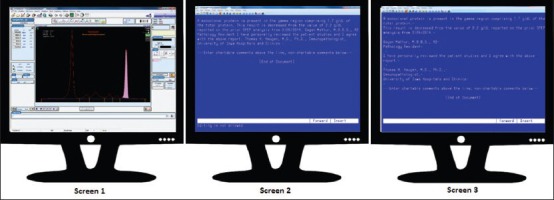
Screen 1 showing Sebia interface, screen 2 showing unformatted transferred interpretation in laboratory information system (LIS) and screen 3 showing formatted interpretation in LIS transferred with the help of AutoHotKeys
MATERIALS AND METHODS
After exploring options for this trivial appearing problem, we evaluated AutoHotkey (http://www.autohotkey.com), a free, open-source macro-creation and automation software utility.[9] Scripts were written in AutoHotkey to create macros that automated mouse and key strokes (script included in the supporting material). The scripts retrieve the specimen accession number, capture user input text, and insert the text interpretation in the correct patient record in the desired format [Figure 2].
Figure 2.
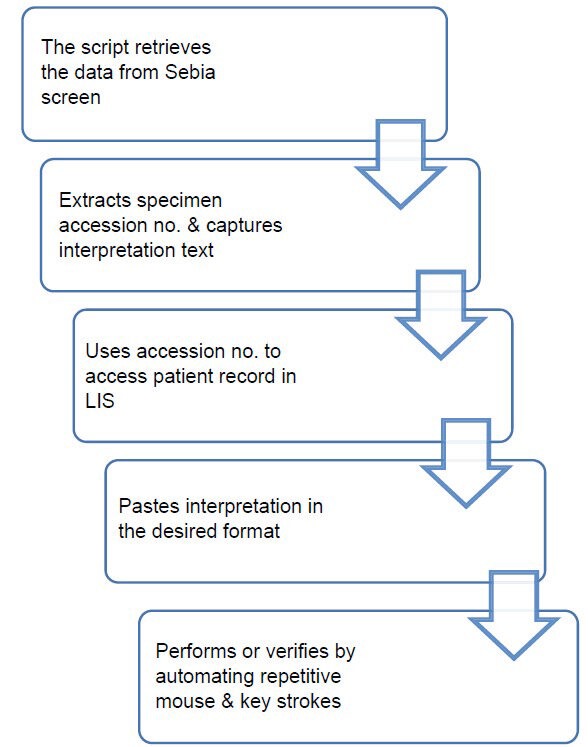
Functions performed by Autohotkey script
AutoHotkey was also used to create abbreviations for various interpretation templates [Table 1]. These keystrokes which are sent in response to typed abbreviations are known as “hotstrings.”[9] In addition, AutoHotkey automated repetitive nonintuitive keys strokes which were required for maneuvering through our LIS. Using AutoHotkey, we were able to save a substantial number of nonintuitive keystrokes involved in sign-out [Table 2].
Table 1.
Hotstrings for templates
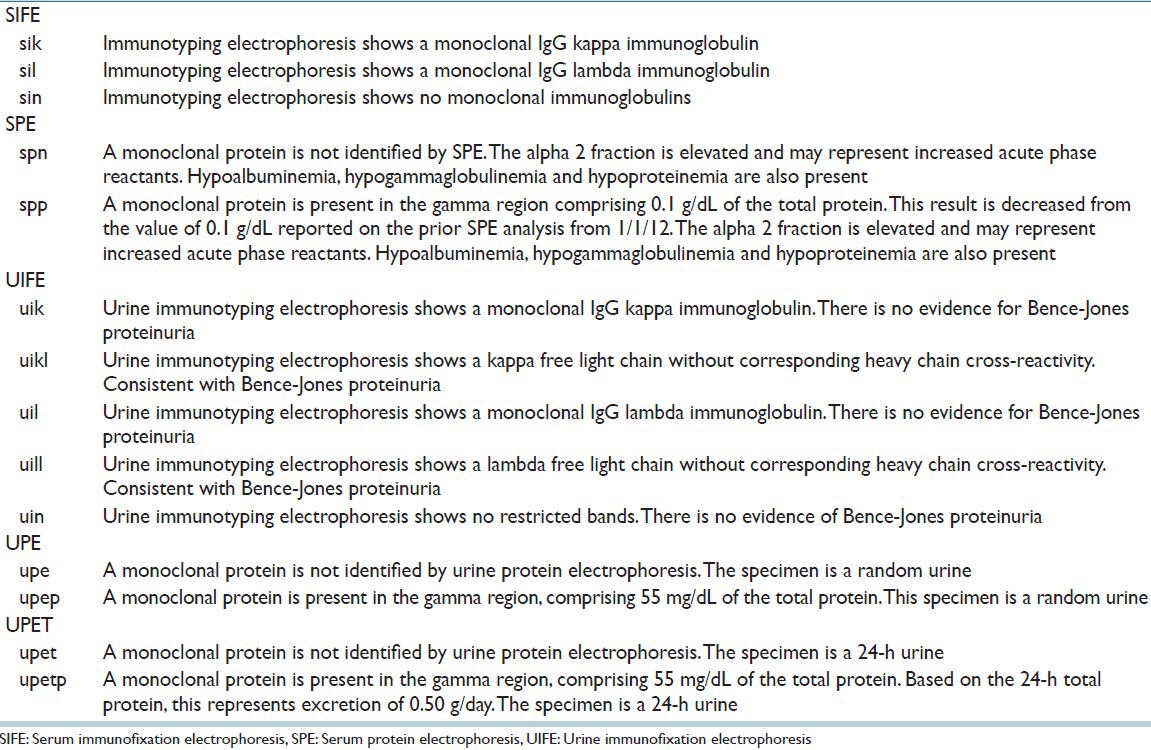
Table 2.
Key strokes to sign-out electrophoresis and number of keystrokes saved
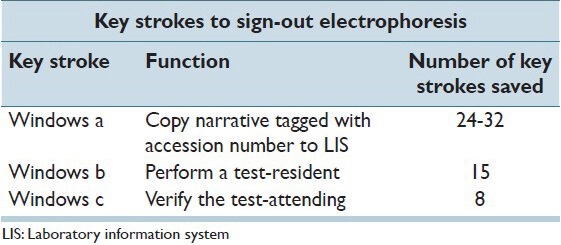
RESULTS
The Autohotkey scripts executed well and accurately transferred narrative interpretation into the LIS in desired text formatting [Figure 1], thus reducing the manual effort of reentering the interpretation and also decreased the possibility for error in text data transfer. The scripts were basically executing copy-paste in an automated way. An important additional feature was that the script acquired both the accession number and the specimen type (e.g. SPE and SIFE for serums and UPE, UPET and UIFE for urines) from the Sebia instrument. Using the accession number and the specimen type, the script opened the patient's record for this specimen in the LIS. This step ensured that the narrative was inserted into the correct patient record and type. Errors in patient and sample identification are minimized. The result was smooth and efficient transfer of data in the correct patient record.
The Autohotkey scripts were easy and intuitive to learn by users. Executing the script for transferring the text data included just two simple key strokes [Table 2], thus facilitating ease of adoption by pathology residents who rotated through the clinical chemistry service. Scripts allow for either preliminary verification by residents or final sign-out by the attending pathologist [Figure 3]. Finally, the scripts promoted a nearly paperless process for data entry into the electronic record.
Figure 3.
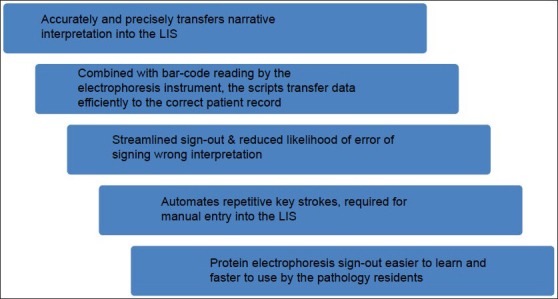
Result of Autohotkry script execution
CONCLUSIONS
Using the open-source AutoHotKey software, we successfully improved the transfer of text data between capillary electrophoresis software and the LIS. Open-source software allows the end user to review, modify, or share the source code, blueprint or design of the software for their own needs, customization, curiosity or troubleshooting under defined terms and conditions.[10] Open-source software are often free or available at low cost. Although open-source software have been successfully used in many fields of medicine like imaging, electronic medical records, electronic health records, public health and bio surveillance, research, etc.,[11] but there is no published data on use of open-source software for interfacing clinical laboratory instruments with the LIS or middleware. Proper interfacing of complex laboratory instruments often requires sophisticated middleware software, but compatibility issues arise from time to time and hinder smooth functioning of an automated laboratory. Open-source software tools should not be overlooked as tools to improve interfacing of laboratory instruments.
Footnotes
Available FREE in open access from: http://www.jpathinformatics.org/text.asp?2014/5/1/36/141990
REFERENCES
- 1.Kurec AS, Lifshitz MS. General concepts and administrative issues. In: Abraham NZ, Bluth MH, Bock JL, Hutchinson RE, Massey HD, Miller JL, et al., editors. Henry's Clinical Diagnosis and Management by Laboratory Methods. 22nd ed. Philadelphia, PA: Elsevier/Saunders; 2011. pp. 3–12.e1. [Google Scholar]
- 2.Killeen AA. The clinical laboratory in modern health care. In: Longo DL, Fauci AS, Kasper DL, Hauser SL, Loscalzo JJ, editors. Harrison's Principles of Internal Medicine. 18th ed. Ch. 53. NewYork City, NY: McGraw-Hill; 2011. [Google Scholar]
- 3.Pantanowitz L, Henricks WH, Beckwith BA. Medical laboratory informatics. Clin Lab Med. 2007;27:823–43. doi: 10.1016/j.cll.2007.07.011. vii. [DOI] [PubMed] [Google Scholar]
- 4.Wagner KL. Middleware to ‘littleware’: Vendors catering to smaller labs. CAP Today. 2011;3:14–18. [Google Scholar]
- 5.Swain M, Patel V. Health Information Exchange among Clinical Laboratories. ONC Data Brief 2014. 2014 Feb;(14) [Google Scholar]
- 6.Krasowski MD, Davis SR, Drees D, Morris C, Kulhavy J, Crone C, et al. Autoverification in a core clinical chemistry laboratory at an academic medical center. J Pathol Inform. 2014;5:13. doi: 10.4103/2153-3539.129450. [DOI] [PMC free article] [PubMed] [Google Scholar]
- 7.Siegler EL, Adelman R. Copy and paste: A remediable hazard of electronic health records. Am J Med. 2009;122:495–6. doi: 10.1016/j.amjmed.2009.02.010. [DOI] [PubMed] [Google Scholar]
- 8.Bowman S. Impact of electronic health record systems on information integrity: Quality and safety implications. Perspect Health Inf Manag. 2013;10:1c. [PMC free article] [PubMed] [Google Scholar]
- 9.autohotkey.com. AutoHotkey-A scripting language for desktop automation Free and Open Source software, licensed under the GNU GPLv2. [Last updated on 2014 Aug 16Last cited on 2014 Jun 13]. Available from: http://www.autohotkey.com .
- 10.opensource.org. Open source initiative. [Last updated on 2014 Jun 09; Last cited on 2014 Jun 09]. Available from: http://www.opensource.org/licenses .
- 11.Wikipedia contributors. List of open-source healthcare software. Wikipedia, the Free Encyclopedia. [Last updated on 2014 Jun 06; Last cited 2014 Jun 13]. Available from: http://www.en.wikipedia.org/w/index.php?title=List_of_open-source_healthcare_software and oldid=611874172 .


